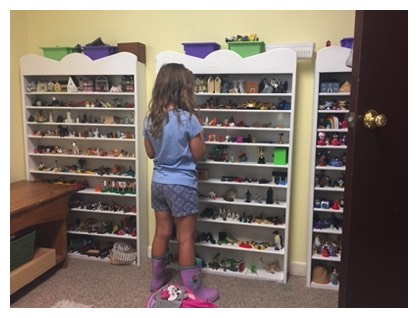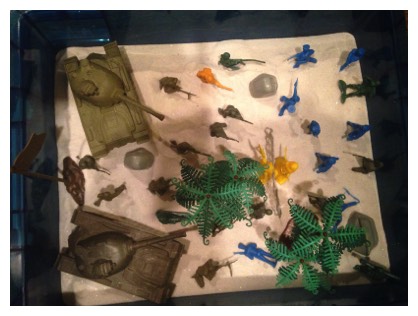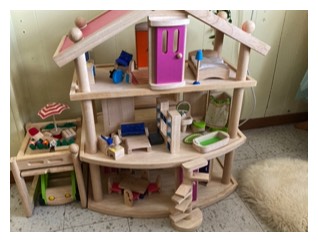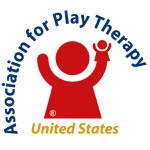
HEATHER CHRISTENSEN, LCSW, RPT-S (She/Her)
Come as you are. I’m glad you are here. People of all genders, sexualities, relationship orientations, abilities, and body shapes are welcome. My approach is trauma-informed, pleasure positive and LGBTQ+ affirming. I am grounded in neurodiversity affirming principles and application. I strive to provide care that is strength-based and culturally responsive.
I am a Licensed Clinical Social Worker in Pennsylvania (Lic#CW020372) and New Jersey (Lic#44SC05061800). I have over 25 years of clinical experience serving children, adolescents, couples, and families.
-
PLAY THERAPY >>
Open or ClosePlay therapy refers to an evidenced-based treatment modality used by specifically trained masters-level professionals. Play therapy has been proven to help children who suffer from emotional, behavioral, and developmental difficulties. Play therapy utilizes the child’s innate impulses to play as a means of connecting and helping the child understand confusing feelings and cope with upsetting events, fears, worries, and conflicts.
Using a fully equipped and regularly sanitized therapeutic playroom, I rely on play therapy and other expressive techniques to understand a child’s experience. Through observation, I am able to identify patterns and themes that emerge in play. My interactions are tailored to the child’s individual interests and preferences. In the beginning stages of forming a therapeutic relationship, I use a non-directive modality called Child-Centered Play Therapy. At times, I rely on more prescriptive and cognitive-behavioral interventions to address specific behavioral concerns.
I aim to create a warm and friendly relationship with the child, accepting the child as they are. I encourage the child to express their feelings, and I reflect these feelings back to them. The child leads and I follow. I seek to understand and to help the child feel and be understood which is the foundation for meaningful personal growth and development.
I am mindful of my responsibility to uphold a child’s confidentiality. Confidentiality is a necessary component to the therapeutic alliance and is essential to healing. I balance the child’s need for privacy with the understanding that they also need their caregiver’s involvement in the change process. Caregivers participate in ongoing consultation which offers an opportunity to be informed about the general progress of treatment, as well as addresses any specific parenting concerns.
• Divorce
• Grief and loss
• Trauma
• Defiant and oppositional behavior
• Excessive fears and worries
• Anger and aggression
• Withdrawn, clingy, or overly compliant behavior
• Making friends and getting along
What Happens in the Playroom?The playroom is a sensory welcoming space that offers children an opportunity to express their thoughts and feelings through play. Every toy in the playroom promotes expression of thoughts and emotions in ways that are unique to each child. I routinely introduce children to the playroom by saying, “You can do almost anything you want in the playroom. If there is something you cannot do, I will let you know.”. This statement serves as an invitation to explore the boundaries and limits of the playroom in a safe way.
As a trained and certified Pet Partner Handler (attested #0339407568), I utilize my veterinarian certified guinea pig, Sunny, who welcomes children to the playroom. Sunny loves to be held and hand-fed. Sunny helps to create a relaxed atmosphere, thus allowing the child to experience me and therapy itself as less threatening. I have found that Sunny serves many therapeutic functions; he is often a transitional object, a reinforcement for behavior change, a cathartic holding object, a metaphor for feelings, a role play participant, and a nonjudgmental attachment and-to mention a few.
Pet Assisted Play Therapy (PAPT) is the synergy of both the human-animal attachment and therapeutic play. It is an emerging field that melds two therapeutic modalities of play therapy and animal assisted therapy and their respective heretical foundations. Children are naturally drawn to the sandtray. I offer both kinetic and Jurassic Therapy Sand. My instructions are simple. “You can use as many or as few miniature as you wish to make a world in the sand. There is no wrong or right way to do it. Whatever you do is just fine.”. Then I serve as witness while they explore and create. I pay attention to thematic material, miniature choices, verbalizations, and use of characters. I am particularly interested in themes that carry over from week to week. This is an incredibly calming activity that, at times, can last an entire session.
Children are naturally drawn to the sandtray. I offer both kinetic and Jurassic Therapy Sand. My instructions are simple. “You can use as many or as few miniature as you wish to make a world in the sand. There is no wrong or right way to do it. Whatever you do is just fine.”. Then I serve as witness while they explore and create. I pay attention to thematic material, miniature choices, verbalizations, and use of characters. I am particularly interested in themes that carry over from week to week. This is an incredibly calming activity that, at times, can last an entire session


Whether it is the BOE Bop bag or the calm-down swing, both serve as a source of sensory regulation.
Art supplies are readily available for those who identify as “artist”. I reinforce that there are no rules about how things must look in art, and that almost anything can be changed or adjusted if the artist wants to do so. The artist is in charge.
The dollhouse and dress-up center offer young children an opportunity to rehearse for real life. Through imaginary play, children practice how to negotiate their actual life. They discover their unique preferences, and act-out ways to get their needs met. Imaginary play is instrumental in working through their unresolved emotions.
There are plenty of therapeutic board games and books for children to choose from. Occasionally, I utilize a more directive approach and suggest a game, activity, or issue-specific book. I find that using this directive approach can be an effective way to offer quick relief to children who are experiencing stress due to various life transitions such as grief and loss, divorce, serious illness, or social struggles. In addition, board games can offer opportunities for children to enhance their socialization skills and build impulse control.
Credentials: Registered Play Therapist-Supervisor (#T-1055) Association for Play Therapy
-
COUPLE THERAPY >>
Open or CloseI welcome all relationship configurations. No topic is taboo. I provide a safe place to explore what is not working in your relationship and why? My style is warm, collaborative, and conversational. Together, we come to understand the origins of unwanted feelings and reactions and its’ impact on the relational dance. We will discover solutions and changes needed to rebuild trust and reconnect.
• Infidelity
• High conflict
• Trauma and attachment
• Stages of blended families
• Effects of substance abuse
• Managing mental illness
• Neurodiversity within the couple
• Queer/non-binary/transgender
• Multi-racial, multi-cultural couples
• Open and polyamorous relationships
Credentials: Chicago Psychoanalytic Institute, Couple Therapy Certificate Program, 2022 graduate
-
CHILD-CENTERED DIVORCE COUNSELING >>
Open or Close
“I used to think my dad was wrong. But now I’m
starting to think my mom is wrong too. I don’t
know who to trust. Who should I trust, Heather?”
~ client, age 8
“My (litigious) divorce has cost me
my children’s college tuitions.”
~ client, father of 3
In my role as helper, I have witnessed the painful effects of long, drawn-out, ugly divorces on children, and it inspired me to pursue training in divorce mediation from the Conflict Resolution Training Program in 2017.
Divorce, in itself, does not harm children! However, exposure to conflict, disrespect and disfunction does. Ending a marriage is hard enough without having to endure the additional trauma caused by an adversarial divorce.
My mediation approach emphasizes the child’s best interest. Using the child’s best interest as a guiding principle makes decisions and compromises much easier to make. My skills as a psychotherapist are especially helpful when creating individualized parenting plans that takes into consideration the developmental, social and emotional needs of each unique child.
I offer a framework for divorcing parents to commit to engaging in doing what is truly best and right for the children despite the anger they might feel toward one another. A child-centered divorce gives parents an opportunity to model healthy conflict-resolution to their children. The mediation process in itself lays the foundation for a new family structure based on integrity and respect. Moreover, it ensures that the child’s voice is included in the forming of a new family structure.
In addition to separation and divorce counseling, I mediate for post-divorce disputes, parenting plan modifications and other co-parenting issues.Credentials: Conflict Resolution Training,
Certification in Mediation, 2017
DIVORCE MEDIATION TRAINING
-
AUTISM SERVICES >>
Open or Close I believe that children will heal, grow, and change to become their true actualized self if they are given an opportunity to move at their own pace in an atmosphere where there is trust, acceptance, and empathic understanding.
I believe that children will heal, grow, and change to become their true actualized self if they are given an opportunity to move at their own pace in an atmosphere where there is trust, acceptance, and empathic understanding.
Play therapy with autistic children still assumes a child-centered approach. The principles remain the same, but the tools and techniques are modified to meet the child’s individual and unique needs. I follow the child’s natural emotional interests while challenging the child toward greater mastery of their social, emotional, and intellectual capacities.
Play therapy serves as an essential component to a treatment team approach. Often the goals and objectives in the playroom are consistent with those of other disciplines including occupational, physical and speech therapy, and other supportive services within the school setting. With your written consent, I initiate and maintain ongoing contact with other significant professionals involved in your child’s life, including the Child Study Team.
If you are an autistic teen (with or without a formal diagnosis from a medical professional), please know that you are safe here. I continue to learn about the beauty and complexity of neurodiversity. While I was trained and educated under a medical model, I have come to reject a model that views variations in neurological development as pathological. You are not a problem to be solved.
I do not rely on or require a formal diagnosis of Autism Spectrum Disorder by a medical professional. Self diagnosis is valid. If you are questioning whether you may be autistic, I encourage you to visit Embrace-autism.com
• Pressure to conform
• Masking
• Executive functioning
• Trauma • Demand avoidance
• Melt down management
• Social anxiety
• Self esteem
• Advocacy for support and accommodations to meet sensory needs
• Understanding and regulating sensory needs
• Co-regulationCredentials: The Interdisciplinary Council on Development and Learning
(ICDL) Greenspan DIR/Floortime Specialist Certification
Certified Autplay Therapy Provider

-
LINKS >>
Open or Close






